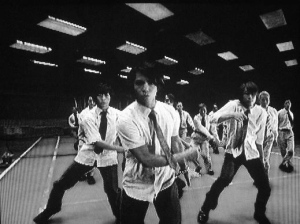Everyone seems to be down on training courses these days.
I'm not.
I think a training course can be a fantastic way to learn, as long as it's part of a bigger effort and not just a formulaic one-off isolated event with no connection to the real world.
As Learning and Development types, how we facilitate training courses is a huge part of our job, and an important way we establish credibility.

As any trainer knows, it's not a lot different from any other type of performance art. If you go on stage and flop, your credibility is destroyed. If you kill (in the cool sense of the word), you can be seen as a credible professional, allowing you to be influential across a whole lot more than just training course provision.
But how do we do that when the average human attention span has slipped to less than that of a goldfish (now down to 8 seconds)?
Three ways to keep learners engaged
When I interviewed Shirley Gaston (from Azesta – experiential learning company), for the Trainer Tools podcast, Shirley talked through her top three ways to ensure that learners stay engaged during the training course (see here for a link to the podcast).
Shirley's starting place is David Meier, the father of accelerated learning:
Never do for learners what they can do for themselves
The three are (in reverse order of importance):
- Get the physical environment right
- Get people moving about
- Get people to do the thinking and the analysis
Get the physical environment right
Most training rooms are not well suited to human habitation, and certainly not to human learning.
This is not rocket science, nor brain surgery, nor setting up email on a Blackberry. It's fairly straightforward stuff.
It's about ensuring there is oxygen and natural light, and wherever possible getting people outside to breathe fresh air and bask in the sunshine. Being outside is energising, and taking activities outside, or allowing pairs or groups to go off and discuss things outside, is a powerful way to keep learners engaged.
Even when inside, ensure the training room has oxygen and natural light and isn't a dingy basement or a fancy hotel function room with no windows – and don't just serve coffee and biscuits, also have natural and healthy foods such as water and fruit that provide energy.
Lastly, create an interesting environment with relevant books, magazines, articles etc. and have sensory stuff like smelly markers and fiddly toys. I'm not entirely convinced of the importance of smelly markers and fiddly toys, but I'll let that go for now.
Get people moving about
Another key aspect of getting the environment right is to ensure it's flexible and spacious enough to allow for lots of movement.
Physical movement is key to keeping learners engaged and energised.
This not only means going outside where possible, but also making use of physical space, such as the four corners of the room which can be used to bring models to life. Each corner representing a box in a 2 x 2 matrix, or the point of view of a particular stakeholder, or anything else you can think of. This not only builds movement into the activity, it requires taking a different physical perspective which can lead to different mental perspectives.
Activities should include movement.
Creating experiential learning activities is a specialty of Shirley Gaston, and she emphasises the importance not just of creating an activity that relates obviously to the learning need (we don't just get up and dance around for the sake of it), but also correctly setting up the activity, naming it (the name may change depending on the learning), and actively reviewing it to maximize its potential to enhance learning.
(I will discuss Active Reviewing in a lot more depth with Roger Greenaway on the Trainer Tools podcast to be released on 10th May 2015)
Get people to do the thinking and analysis
Don't tell people stuff they can work out for themselves.
However brilliant and hilarious you are at presenting there is no substitute for letting people figure stuff out for themselves, ideally though lively discussion with Other People.
The social aspect, particularly important for people who learn through discussion, is one of the main advantages of group learning.
For example, if there is a process model, such as Kotter's model on change, get the learners to work out the order of the steps for themselves. This will give them a far greater depth of understanding and insight than you just telling them or putting it up on a PowerPoint slide.
Discussing, thinking, analysing and reflecting are so much more effective than sitting and listening.
Click this link to hear the discussion on the Trainer Tools podcast
Everyone seems to be down on training courses these days.
I'm not.
I think a training course can be a fantastic way to learn, as long as it's part of a bigger effort and not just a formulaic one-off isolated event with no connection to the real world.
As Learning and Development types, how we facilitate training courses is a huge part of our job, and an important way we establish credibility.

As any trainer knows, it's not a lot different from any other type of performance art. If you go on stage and flop, your credibility is destroyed. If you kill (in the cool sense of the word), you can be seen as a credible professional, allowing you to be influential across a whole lot more than just training course provision.
But how do we do that when the average human attention span has slipped to less than that of a goldfish (now down to 8 seconds)?
Three ways to keep learners engaged
When I interviewed Shirley Gaston (from Azesta - experiential learning company), for the Trainer Tools podcast, Shirley talked through her top three ways to ensure that learners stay engaged during the training course (see here for a link to the podcast).
Shirley's starting place is David Meier, the father of accelerated learning:
Never do for learners what they can do for themselves
The three are (in reverse order of importance):
- Get the physical environment right
- Get people moving about
- Get people to do the thinking and the analysis
Get the physical environment right
Most training rooms are not well suited to human habitation, and certainly not to human learning.
This is not rocket science, nor brain surgery, nor setting up email on a Blackberry. It's fairly straightforward stuff.
It's about ensuring there is oxygen and natural light, and wherever possible getting people outside to breathe fresh air and bask in the sunshine. Being outside is energising, and taking activities outside, or allowing pairs or groups to go off and discuss things outside, is a powerful way to keep learners engaged.
Even when inside, ensure the training room has oxygen and natural light and isn't a dingy basement or a fancy hotel function room with no windows - and don't just serve coffee and biscuits, also have natural and healthy foods such as water and fruit that provide energy.
Lastly, create an interesting environment with relevant books, magazines, articles etc. and have sensory stuff like smelly markers and fiddly toys. I'm not entirely convinced of the importance of smelly markers and fiddly toys, but I'll let that go for now.
Get people moving about
Another key aspect of getting the environment right is to ensure it's flexible and spacious enough to allow for lots of movement.
Physical movement is key to keeping learners engaged and energised.
This not only means going outside where possible, but also making use of physical space, such as the four corners of the room which can be used to bring models to life. Each corner representing a box in a 2 x 2 matrix, or the point of view of a particular stakeholder, or anything else you can think of. This not only builds movement into the activity, it requires taking a different physical perspective which can lead to different mental perspectives.
Activities should include movement.
Creating experiential learning activities is a specialty of Shirley Gaston, and she emphasises the importance not just of creating an activity that relates obviously to the learning need (we don't just get up and dance around for the sake of it), but also correctly setting up the activity, naming it (the name may change depending on the learning), and actively reviewing it to maximize its potential to enhance learning.
(I will discuss Active Reviewing in a lot more depth with Roger Greenaway on the Trainer Tools podcast to be released on 10th May 2015)
Get people to do the thinking and analysis
Don't tell people stuff they can work out for themselves.
However brilliant and hilarious you are at presenting there is no substitute for letting people figure stuff out for themselves, ideally though lively discussion with Other People.
The social aspect, particularly important for people who learn through discussion, is one of the main advantages of group learning.
For example, if there is a process model, such as Kotter's model on change, get the learners to work out the order of the steps for themselves. This will give them a far greater depth of understanding and insight than you just telling them or putting it up on a PowerPoint slide.
Discussing, thinking, analysing and reflecting are so much more effective than sitting and listening.
Click this link to hear the discussion on the Trainer Tools podcast








